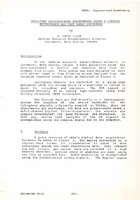| dc.contributor.author | Crowe, D. Vance | |
| dc.date.accessioned | 2018-10-11T14:05:08Z | |
| dc.date.available | 2018-10-11T14:05:08Z | |
| dc.date.issued | 1979/12 | |
| dc.identifier | 525 | |
| dc.identifier.govdoc | CP-25/2 | |
| dc.identifier.uri | http://hdl.handle.net/20.500.12489/63 | |
| dc.description.abstract | At the Defense Research Establishment Atlantic Dartmouth, Nova Scotia, Canada a data aquisition sytem been engineered to monitor and beamform data from element line arrays. This system has been designed to with either towed or free floating arrays deployed from Canadian research vessel Quest as depicted in Figure 1. in has 30- work the Hydrophone signals are converted to a pulse code modulated (PCM) bit stream which is transmitted or cabled to Quest for recording and analysis. The PCM signal is recorded directly on an analog tape recorder using high density recording (HDR) techniques. The digital data are fed directly to a minicomputer system for analysis of the entire bandwidth of the hydrophone signals, originally sampled at 2000Hz. When CW experiments are performed, the data are preprocessed using a multi-channel digital filter-translator. The signals are complex heterodyned, low pass filtered and decimated. In this way, narrow band analysis of the CW signals is accomplished using the complex signal fed to the computer | |
| dc.format | 13 p. : ill. ; digital, PDF file | |
| dc.language | English | |
| dc.publisher | NATO. SACLANTCEN | |
| dc.source | In: Real-time, general purpose, high-speed signal processing systems for underwater research (SACLANTCEN Conference Proceedings CP-25), Part 2, 1979, pp. 27-1 - 27-13. | |
| dc.subject | Sonar | |
| dc.subject | Signal processing | |
| dc.subject | Beamforming | |
| dc.subject | Computer programs | |
| dc.title | Real-time expanded-band beamforming using a complex heterodyner and fast array processor | |
| dc.type | Papers and Articles | |
| dc.type | Conference Proceedings (CP) | |
